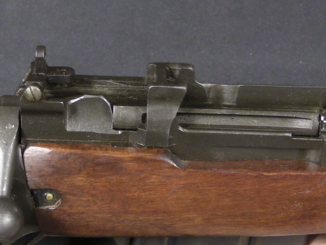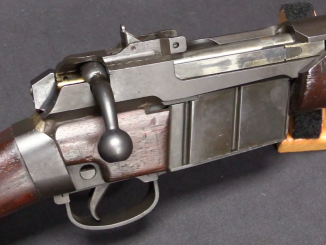The Pritchard bayonet for the Webley revolver is one of the more photogenic and less truly practical weapons to come out of the Great War. Designed by one Captain Pritchard after he spent a year in France in 1915-1916 with the Royal Berkshire Regiment, the idea was to use the front 8 inches or so of a sword on a cast gunmetal hilt to create a bayonet mounted on a British service revolver. He first presented the idea to the Wilkinson Sword Company, but they were too busy making sabers and rifle bayonets, and suggested that having to sacrifice usable sword blades for production would make it quite the expensive endeavor.
Pritchard next took his idea to W.W. Greener, where he found a more receptive audience. Greener had a large supply of surplus French Gras bayonets, which were cheap and served as excellent donors for the Pritchard bayonets. Something like 200 were made in total – not formally adopted by the British but available for commercial sale to officers who might want them. While some may have seen service, no hard evidence has been found to prove any combat action with them.
Over the decades, a great many fake and reproduction Pritchard bayonets have been made – many times more than there are originals. As far as I can determine, this one is a legitimate original (although it may have a replacement locking lever). A few things to look for in authenticating a Pritchard are engraved patent and manufacturer marks (most reproductions have no manufacturer logo and a stamped patent number) and a quality casting. When you hold the blade and tap the handle with a hard object, it should ring bright and bell-like (which this one does).




So what was the plan with this in the trenches? Was the user supposed to sneak up behind the intended victim and then run him through, withdrawing the revolver after determining the victim was totally dead? I know, the revolver is much handier in the trench environment than a full-length rifle, but this is ridiculous!
Would be tacticool word suitable here: this is surely visually potent but of vague usability.
I found small list of bayonet with pistols:
http://www.guns.com/2013/03/12/5-knife-equipped-handguns-pistols-with-a-point/
notice that despite historically unsuccessful there are still attempts to make it, notice modern examples:
bayonet for CZ-SP01 automatic pistol and two generic (not pattern-specific) bayonets.
–
Anyway I found all bayonet-revolver awkward for simple reason: revolver holster are not designed to hold revolver with bayonet
I used to think that these bayonet-pistol contraptions were a kind of joke, a largely-ornamental talking piece, perhaps akin to mounting deer antlers on a stuffed jack rabbit, and concocting a tall tale to go with it, just to see whoever might be gullible enough to fall for the gag.
It was kind of sad to learn that bayoneted pistols were actually taken seriously as a weapon. But in the same vein, I suppose the Pickelhaube spiked helmet could conceivably have been designed as a thrusting weapon for the wearer with a strong and supple neck — though I’d highly suspect that any training manuals for such use are fake … or at least I’d certainly hope so. 🙂
This seems like one of those ideas that somebody would have to attempt though the solid brass handle makes the revolver much less efficient. More than anything it speaks to me of the brutality of trench warfare and how close the action was. I can’t imagine going on a trench raid armed primarily with a revolver and, as noted above, this configuration negates the holster. The soldier would have to start the fight with the bayonet Webley in hand rather than use the revolver as a back up.
I am always amazed at the level of detail you dig up regarding the back stories of the weapons you feature.
Please lets not get too ‘royal’ here: There never was a ‘Royal Army’ I’m afraid. Thanks for the excellent stuff Ian!
“never was a ‘Royal Army’ I’m afraid”
To be exact there was not British Royal Army, but during First World War there was Regio Esercito. Can anyone explain why British Army was not Royal? I found explanation that exist by order of the parliament and thus is not Royal, but I am not sure whatever it is true, or whatever it is de facto xor official explanation.
It had to do with how they were originally raised. The Royal Navy was recruited and paid for by the central government, so they were the “Royal” navy because they answered directly to the king.
Army soldiers however were recruited and paid for by local nobles of one sort or another. The noble was in feudal times obligated to provide a specified number of armed and trained men for so many days per year to the king (or queen) as part of their feudal obligations. For time over that annual service, the king had to pay the noble extra.
Therefore, there wasn’t a “royal” army because there was no permanent standing army belonging to the king or queen. Instead, there were feudal armies belonging to individual dukes, earls, or whatever. In addition, the king may hire mercenaries for a particular war or campaign, sometimes foreign ones.
Now some regiments did belong to the king, but this was as part of his role as a major landlord in his own right. These were often styled as “The King’s Own” or some such honourific.
The RAF name doesn’t fit into this pattern as they didn’t exist until long after these practices became obsolete, so the “royal” title was bestowed on them as a modern invention.
Hence, there’s a Royal Navy, the Royal Marines (as part of the navy), and a Royal Air Force, but the army is simply the British Army.
Berkshire is a pretty Royal place – the Royal Berkshire Hunt is immortalised in Cockney rhyming slang – I don’t doubt it has a “Royal” regiment. It is, however, pronounced Bark-shuh.
I rather suppose that if you had prisoners that they may not be convinced that you would execute them for some petty non-compliance, but that you probably would stab them a little bit.
See http://www.quora.com. Why do we have a Royal Navy and a Royal Air Force but no Royal Army.
I’ve seen modern versions you attach to the rail in front of the trigger guard. No thanks. These WOULD be a surprise for some yutz trying to grab your handgun, however.
POKE! POKE! POKE!
It should be noted that pulling the trigger would aid withdrawal.
Extra care should be needed when reloading.
MG has the gist of it since regiments were locally raised and equipped by landowners loyal to the crown, hence the county regiment structure which proved so devastating to certain towns in WW1 as entire regiments were shattered. IIRC the genesis of the centralized British Army was Oliver Cromwell’s parliamentarian “New Model Army” during the English Civil War 1642-1651 which beat the Royalist army…..and led to the King losing his head. Therefore the British Army will never be called “Royal”, those lizard people have awfully long memories.
I saw one also made from Gras bayonet made for Gasser revolver, but it had wooden handle.
Purchased a repro bayonet several years ago and tried it on a MkVI Webley. It immediately converts a pretty good instinctive fire revolver into a heavy clumsy arm difficult to use for snap shooting. In aimed fire it shoots about 1′ low at 210 yds. As a dagger it is awkward to use.
It is neither fish nor foul and its lack of success on the market shows the opinion that its intended market had for it. However like many failed arms it is a dandy collectors item.
Bayonets on pistols and submachineguns make perfect sense for trench raids or fighting in someone’s house (FISH).
Early in WW1, pistols were popular among trench-raiders because of their maneuverability in cramped trenches and ability to fire around corners. Consider what happens if you leap into a trench and shoot 6 enemy …. then a seventh enemy enters the trench. Do you politely ask him to “Please wait a minute old chap while I reload my revolver.”
When SMGs started replacing pistols – at the end of WW1 – it made perfect sense to include bayonet lugs.
When the Canadian Army issued me with Sterling SMGs – during the 1970s and 1980s – it made perfect sense to carry a bayonet.
Ian, or any other knowledgeable, kind soul; I was wondering if a Pritchard Bayonet would fit on a MK I? My thanks in advance!